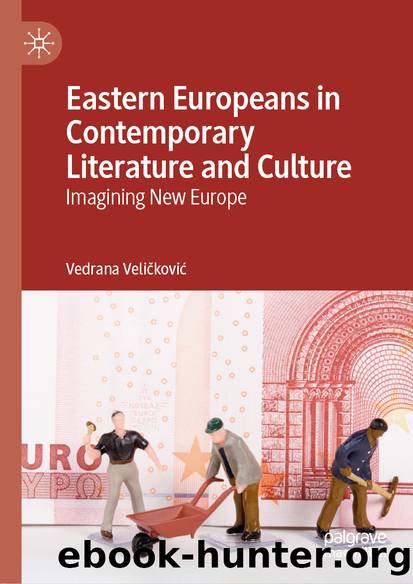Eastern Europeans in Contemporary Literature and Culture by Vedrana Veličković

Author:Vedrana Veličković
Language: eng
Format: epub
ISBN: 9781137537928
Publisher: Palgrave Macmillan UK
In particular, Entropa managed to disturb and offend one of the EUâs most recent members, Bulgaria , which was notoriously represented as a system of squat toilets, a familiar piece of the Ottoman legacy throughout the Balkans and a contentious site in both Eastern and Western imagination, as noted in chapter âItâs a Free World:â Eastern Europeans in Contemporary Media and Filmâ. So when Bulgarian officials complained and Bulgariaâs place was consequently covered with a black cloth it became another absent member next to the United Kingdom , although, as Zigelyte importantly points out, âthe mode of absence of these two countries is significantly differentâ, and particularly now in the post-Brexit context. 18 The use of stereotypes can be seen as a deliberate strategic actâthat is, âinstead of representing, Entropa poses questions on representation and asks how and why certain ideas of Europe take shapeâ. 19 In Other words, this is not only about whether a country is represented through more appealing images such as a box of chocolates, but about how these values come to be attached to certain countries, regions, and people . In this regard, Entropa can be read as a piece of âwriting back â to Balkanist stereotypes specifically, and one which demands ways of seeing beyond what is present or absent from the modelling kit. Its deliberate focus on the partial and the fragmentaryâthe representation of each EU country through a single stereotype âopens up a gap that urgently demands to be filled. Thus Entropa invites us to move beyond seeing Bulgaria , through a single image, as EUâs backward and poor member signified by the image of an outdated toilet. Rather, I would suggest, it creates a space to decode its ostensibly didactic message by encouraging us to unearth the diverse history of the Balkans beneath a simplified and reductive image of a squat toilet. At the same time, it allows a rethinking of the complex reasons of various forms of postcommunist dysfunction (such as rampant corruption, a criminalized oligarchy, closing all channels of political participation and actively promoting savage capitalism , as usefully explained by Igor Å tiks) as well as highlighting EUâs paternalistic and neo-colonial attitude towards its new and aspiring members (such as a focus on stability rather than on improving the standards of living, the imposition of harsh neoliberal measures under false humanitarianism). 20 As I show later in the chapter, Kassabovaâs memoir can be read as operating precisely within this framework.
In the lively tradition of Czech satire, the film Czech Dream raises similar questions of absence and presence. It opens by juxtaposing jarring images of people queuing up in front of empty shops in 1972 with footage of the 1989 Velvet Revolution and more recent images of people practically trampling over each Other and falling over metal barriers to be first through the doors of a newly opened hypermarket. Once inside they obediently push their shopping trolleys. From the outset, the two student directors create a powerful and uncanny image:
Download
This site does not store any files on its server. We only index and link to content provided by other sites. Please contact the content providers to delete copyright contents if any and email us, we'll remove relevant links or contents immediately.
The Japanese by Christopher Harding(1085)
Watercolor With Me in the Forest by Dana Fox(753)
A Theory of Narrative Drawing by Simon Grennan(742)
The Story of the Scrolls by The Story of the Scrolls; the M(725)
Glittering Images: A Journey Through Art From Egypt to Star Wars by Camille Paglia(717)
Boris Johnson by Tom Bower(620)
This Is Modern Art by Kevin Coval(597)
The Art and Science of Drawing by Brent Eviston(588)
Frida Kahlo by Frida Kahlo & Hayden Herrera(584)
AP Art History by John B. Nici(575)
Banksy by Will Ellsworth-Jones(569)
War Paint by Woodhead Lindy(551)
Van Gogh by Gregory White Smith(547)
Draw More Furries by Jared Hodges(544)
About Looking by John Berger(543)
Scenes From a Revolution by Mark Harris(542)
Ecstasy by Eisner.;(535)
100 Greatest Country Artists by Hal Leonard Corp(523)
Young Rembrandt: A Biography by Onno Blom(513)
